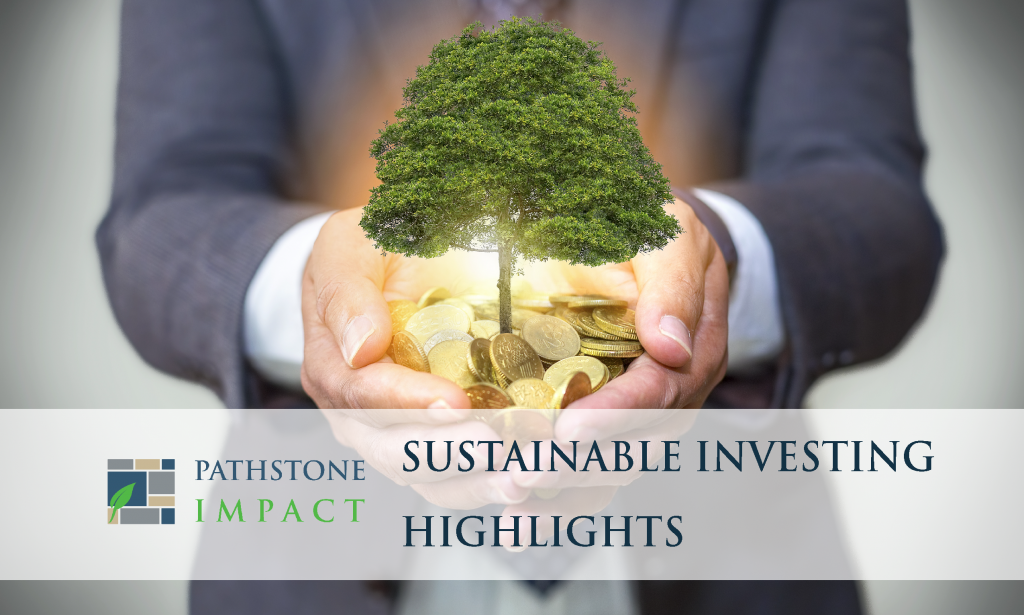Sustainable Investing Highlights Summary:
- Weather change and the increased frequency of natural disasters indicate that global climate is experiencing dramatic change, and the Biden administration is taking steps that strive to slow the pace of this change.
- Diversity, equity, and inclusion (“DEI”) are expected to be more than just a buzzword for businesses and investors. DEI may well be a tailwind that shapes policies and practices in corporate America as companies react to social issues and seek to address growing DEI concerns within their recruitment process.
- As the country’s economy rebounds from the lockdown of 2020, there is an expectation that infrastructure investment will be part of the next fiscal stimulus measure that is passed by Congress.
- The economy’s path towards a healthy reopening faces a headwind as many individuals contemplate their safety and health concerns prior to engaging the services provided by businesses and the government. These concerns are being alleviated as the government rolls out COVID-19 vaccines to states.
Read on to learn more.
Social Cost of Carbon and the SunShot Initiative
Weather change and the increased frequency of natural disasters indicate that global climate is experiencing dramatic change, and the Biden administration is taking steps that strive to slow the pace of this change. The pace of climate change over the next decade will depend mainly on the amount of carbon dioxide emitted into the atmosphere and Earth’s sensitivity to emissions. Many scientists have noted that the impact of climate change as it pertains to risk should not be underestimated. For instance, “Climate change is exposing the tragedy of undervaluing resilience, ignoring systemic risks, and not investing upfront. Changing consumer preferences and new climate policies means that businesses need credible transition plans that show how they will seize opportunities in the transition to net-zero—or, put simply, they will cease to exist.” The social cost of carbon and the SunShot Initiative are two levers that are being pulled to help push businesses and policymakers forward in their quest towards climate change adaptation.
The social cost of carbon (“S.CO2”) seeks to quantify climate risk by translating it into a monetary value that might nudge businesses and policymakers to act on climate change. S.CO2 measures the economic harm from those impacts expressed as the dollar value of the total damages from emitting one ton of carbon dioxide into the atmosphere. It provides businesses and government agencies with an estimate of the overall cost of carbon emissions they emit as they conduct their operations.
Recently, the Biden administration issued an executive order directing the climate team to publish an interim social cost of carbon within 30 days. The executive order cites that, “Agencies must capture the full costs of greenhouse gas emissions as accurately as possible, including by taking global damages into account. Doing so facilitates sound decision-making, recognizes the breadth of climate impacts and supports the United States’ international leadership on climate issues. The “social cost of carbon” (SCC), “social cost of nitrous oxide” (SCN), and “social cost of methane” (SCM) are estimates of the monetized damages associated with incremental increases in greenhouse gas emissions. They are intended to include changes in net agricultural productivity, human health, property damage from increased flood risk, and ecosystem services’ value. The social cost is essential for agencies to accurately determine the social benefits of reducing greenhouse gas emissions when conducting cost-benefit analyses of regulatory and other actions.”
The SunShot Initiative was launched in 2011 by the government to lower the cost of solar energy as a solution in the fight against climate change. The SunShot Initiative supports robust research and development that enables a lower cost and advances the flexibility and performance of solar technologies. The initiative strives to help deliver technology that is more resilient and better able to integrate and support the electrical grid.
DEI as a 2021 Tailwind
Diversity, equity, and inclusion (“DEI”) are expected to be more than just a buzzword for businesses and investors. DEI may well be a tailwind that shapes policies and practices in corporate America as companies react to social issues and seek to address growing DEI concerns within their recruitment process. Since June 2020, in the wake of social unrest that engulfed the United States, the conversation around racial and gender inequality has gained traction with companies rethinking and evaluating their diversity, equity, and inclusion strategies.
Many companies, such as JPMorgan Chase & Co and Walmart, have expressed their solidarity with minority communities, pledged money to fight discrimination, and promised to embrace diversity in their workforces. As one example, JP Morgan Chase has pledged $30 billion to advance racial equity. NASDAQ has also committed to addressing racial inequality within corporations that are listed on its quotation system. NASDAQ has pushed for a proposal through SEC “that will require most of its more than 2,500 listed companies to have at least one director in the coming years who identifies as a woman and another who is Black, Hispanic, Native American, LGBTQ+ or part of another underrepresented community.”
DEI is both beneficial to minorities and is increasingly viewed as a long-term financial benefit to companies with strong DEI commitment. For instance, a 2018 study by global consulting firm McKinsey & Company shows a strong correlation between inclusive DEI and financial performance. According to the study, “companies in the top quarter for racial and ethnic diversity are 35% more likely to generate higher returns.”
The commitment to bridge the racial gap also gained momentum with the recent executive order signed by the White House’s current occupant. The order would “conduct equity assessments of its agencies and reallocate resources to “advanc[e] equity for all, including people of color and others who have been historically underserved, marginalized and adversely affected by persistent poverty and inequality.”
ESG and the Big Push for Green Infrastructure
As the country’s economy rebounds from the lockdown of 2020, there is an expectation that infrastructure investment will be part of the next fiscal stimulus measure that is passed by Congress. Investors, individuals, and institutions that are inclined to align their investment with their values see a clear focus on green infrastructure, such as renewable energy and more resilient power grids, as an opportunity to boost exposure to positive environmental, social, and governance (“ESG”) solutions within their investment portfolios.
Carbon-intensive power generation within the U.S. energy infrastructures has arguably reached the end of its lifecycle. Outdated and at an economic disadvantage in many regions, in comparison to renewables, older fossil fuel power plants are not meeting today’s requirements as put forward by many developed economies. Many investors believe the Build, Back, Better policy of the current administration will help put the United States back on the map with other developed economies that are embracing a robust and sustainable infrastructure. Investors are expected to see an inflow of funds and a big push for sustainable green infrastructures, communication, transportation, and transition towards renewable energy. The Build, Back, Better plan is expected to spend approximately $2 trillion on infrastructure. The spending would serve “as a wedge for economic development, focused on rebuilding roads and bridges and expanding zero-emission mass transit and electric-car infrastructure.”
To achieve the big push for green infrastructure, the Biden administration signed an executive order. “The order catalyzes the creation of jobs in construction, manufacturing, engineering, and the skilled-trades by directing steps to ensure that every federal infrastructure investment reduces climate pollution and that steps are taken to accelerate clean energy and transmission projects under federal siting and permitting processes in an environmentally sustainable manner, […], advance projects that reduce emissions of toxic substances and greenhouse gases from existing and abandoned infrastructure and that prevent environmental damage that harms communities and poses a risk to public health and safety – such as projects to reduce methane emissions, oil and brine leaks, and other environmental harms from tens of thousands of former mining and well sites.”
The stakes are high for companies and governments to develop resilient and sustainable infrastructure within physical and digital realms. Investments in these areas can be viewed as a modern-day arms race. For instance, the lockdown of 2020 exposed weaknesses within American infrastructure and its supply chain and through the disruption in in-person learning. The explosion of learning and working from home highlights the digital divide between the haves and the have nots. Closing the digital infrastructural divide requires a robust inflow of funds into telecommunication technologies such as 5G and, eventually, 6G.
Businesses Helping Out with COVID-19 Vaccination
The economy’s path towards a healthy reopening faces a headwind as many individuals contemplate their safety and health concerns prior to engaging the services provided by businesses and the government. These concerns are being alleviated as the government rolls out COVID-19 vaccines to states. Since the vaccine roll-out began, businesses have made a series of commitments to help the government reach vaccine milestones. Amazon, Microsoft, Starbucks, the National Football League (“NFL”), and Google are among the businesses that made commitments to help the government with its vaccination program.
Google offered to open its facilities for COVID-19 vaccination use. According to a post by Sundar Pichai, CEO of Google and Alphabets, “Google also will expand information panels within search results to show local vaccine distribution information as well as a ‘Get the Facts’ project to provide ‘authoritative information’ about the vaccines, getting vaccines to billions of people won’t be easy, but it’s one of the most important problems we’ll solve in our lifetimes.”
Microsoft is another big tech company helping with the COVID-19 vaccination. The tech giant offered its campus in Seattle as a vaccination site and went further to create a COVID-19 dashboard that tracks vaccine distribution and administration. A statement by Dr. Jha, Dean of the Brown School of Public Health, on Microsoft dashboard, “There is a great urgency to vaccinate people quickly, to save lives and build resilience against new variants and eventually end the pandemic. But, unless we are tracking vaccinations closely, we can’t understand if we are making progress and why some states and countries are doing so much better at getting shots into arms than others, […], The new dashboard is also unique in that it shows U.S. data on vaccination distribution alongside data on cases, hospitalizations and deaths. This allows us to see how vaccination progress compares to the size of the outbreak in each state.”
The NFL recently offered its thirty stadiums for use as COVID-19 vaccine sites. The news about using NFL stadiums as mass vaccination sites came as the government presses on to meet its one hundred million vaccination in one hundred days. According to Roger Goodell, Commissioner of the NFL, “our 32 member clubs are committed to doing our part to ensure that vaccines are as widely accessible in our communities as possible. To that end, each NFL team will make its stadium available for mass vaccinations of the general public in coordination with local, state, and federal health officials. This is currently being done at seven NFL stadiums today. We can expand our efforts to stadiums across the nation more effectively because many of our clubs have offered their facilities previously as COVID testing centers as well as election sites over the past several months.”
Sources:
- https://www.npr.org/2021/02/02/963014373/how-fast-will-biden-need-to-move-on-climate-really-really-fast
- https://www.brookings.edu/blog/future-development/2021/02/04/secular-stagnation-climate-action-and-the-natural-rate-of-interest/
- https://www.barrons.com/articles/corporate-disclosure-is-essential-to-stopping-climate-change-51611928800
- https://www.bloomberg.com/news/articles/2021-01-22/how-do-you-put-a-price-on-climate-change-michael-greenstone-knows
- https://www.nationalgeographic.com/environment/2021/01/this-single-number-could-reshape-our-climate-future/
- https://www.whitehouse.gov/briefing-room/presidential-actions/2021/01/20/executive-order-protecting-public-health-and-environment-and-restoring-science-to-tackle-climate-crisis/
- https://www.bloomberg.com/news/articles/2021-01-07/what-we-learned-from-the-u-s-s-bold-plan-to-make-solar-cheaper
- https://www.energy.gov/eere/solar/sunshot-initiative
- https://www.cnbc.com/2021/02/01/walmart-donates-14-million-dollars-as-part-of-pledge-to-advance-racial-equity.html
- https://www.jpmorganchase.com/impact/path-forward
- https://www.blackenterprise.com/corporate-america-has-a-role-in-narrowing-the-wealth-gap/
- https://www.mckinsey.com/business-functions/organization/our-insights/delivering-through-diversity#:~:text=In%20our%202017%20data%20set,peers%20on%20EBIT%20margin%2C%20and
- https://www.whitehouse.gov/briefing-room/presidential-actions/2021/01/20/executive-order-advancing-racial-equity-and-support-for-underserved-communities-through-the-federal-government/
- https://www.barrons.com/articles/the-green-energy-majors-set-to-benefit-from-europes-net-zero-target-51612802839
- https://www.marketwatch.com/story/opportunity-in-america-starts-with-fixing-the-internet-says-social-investing-pioneer-11612977158
- https://www.brookings.edu/research/how-biden-and-congress-can-use-covid-related-corporate-stimulus-to-boost-climate-resilience/
- https://www.wsj.com/articles/buttigieg-pledges-to-support-bidens-2-trillion-infrastructure-plan-11611259580
- https://www.whitehouse.gov/briefing-room/statements-releases/2021/01/27/fact-sheet-president-biden-takes-executive-actions-to-tackle-the-climate-crisis-at-home-and-abroad-create-jobs-and-restore-scientific-integrity-across-federal-government/
- https://www.bloombergquint.com/technology/forget-5g-the-u-s-and-china-are-already-fighting-for-6g-dominance
- https://www.wsj.com/livecoverage/covid-2021-02-10
- https://www.usatoday.com/story/tech/2021/01/25/google-opening-covid-vaccination-sites/6698019002/
- https://www.cbsnews.com/news/starbucks-covid-vaccine-rollout-washington/
- https://blogs.microsoft.com/on-the-issues/2021/02/05/microsoft-covid-19-vaccine-tracking-dashboard-federal-goal/
- https://www.nfl.com/news/roger-goodell-president-joe-biden-offering-stadiums-vaccine-sites
Please see the PDF version of this article for citations and important disclosures.







